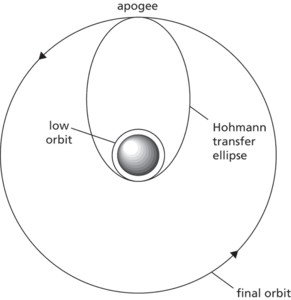A specific fuel-saving trajectory for a spacecraft moving from one orbit to another. It is used, for instance, to travel from the Earth’s orbit to that of the planet Mars. To use the least fuel possible, the vehicle leaves the Earth’s orbit at the transfer orbit’s perihelion (closest point to the Sun) and joins Mars’s orbit at the transfer orbit’s aphelion (point furthest from the Sun). The spacecraft’s orbit is named after the German engineer Walter Hohmann, who calculated it in 1916.

A spacecraft in low Earth orbit (LEO) can change to a higher orbit in the same plane with minimum fuel expenditure by utilizing the Hohmann transfer orbit. Whilst in LEO the spacecraft fires its engines to increase velocity, causing the trajectory to become elliptic. This ellipse is carefully calculated to attain the desired final altitude. At this point the engines are again fired and the spacecraft transfers to the final orbit.
Credit: Research Machines plc
An elliptical orbit that carries a spacecraft from one circular orbit to a different circular orbit when both orbits lie in the same plane. In transferring from a low orbit to a higher one, the spacecraft engines fire to accelerate the craft into an elliptical orbit that intersects the higher orbit. The spacecraft travels through half the ellipse. As it arrives at the higher orbit, the engines fire again to accelerate it into the higher orbit. The same manoeuvre can also be used in reverse to bring a spacecraft into a lower orbit. In practice, the two orbits may not be perfectly circular and therefore are not coplanar, in which case the transfer orbit is slightly less than 180°, when it is known as a Type I Hohmann transfer, or slightly more than 180°, when it is known as a Type II Hohmann transfer. The manoeuvre was devised by the German engineer Walter Hohmann (1880–1945).
- Bidault, Georges (1899–1982)
- bidirectional network
- bidirectional reflection distribution
- bidirectional shift register
- bidirectional transducer
- bidirectional transistor
- BIDMAS
- bid-rent theory
- bid–ask spread
- Bieberbach conjecture
- Biela, Comet 3D/
- Biela, Wilhelm von
- biennial
- BIF
- BiFET
- Biffen, Sir Rowland Harry
- bifilar suspension
- bifilar winding
- bifurcation
- bifurcation ratio
- BIG
- Big Bang
- big bang
- Big Bang theory
- big bang theory